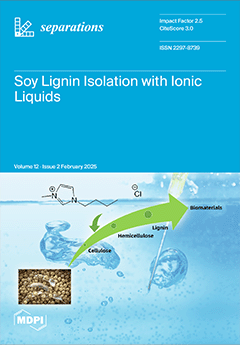Enriched lithium isotopes (
6Li and
7Li) are essential in the nuclear energy industry, where
6Li is bombarded with neutrons to produce tritium for fusion reactions, while
7Li is used as a core coolant and pH regulator. Separation of
[...] Read more.
Enriched lithium isotopes (
6Li and
7Li) are essential in the nuclear energy industry, where
6Li is bombarded with neutrons to produce tritium for fusion reactions, while
7Li is used as a core coolant and pH regulator. Separation of
6Li and
7Li by electromigration is a promising method for producing enriched lithium isotopes that fulfill industrial needs. In this work, based on a previously proposed biphasic system electromigration routine, a three-stage system of ‘LiCl aqueous solution (anolyte)|B12C4-[EMIm][NTf
2] organic solution|NH
4Cl aqueous solution (catholyte)’ was constructed and the rules of lithium isotope separation and lithium-ion migration investigated. It was shown that the isotope enrichment effect of the catholyte was greatly affected by the experimental conditions, while that of the organic solution was less affected. As the B12C4 concentration increased, enhancement of
7Li enrichment in the catholyte and
6Li enrichment in the organic solution was observed, and α(C/O) and α(O/A) reached 0.975 and 1.018 at B12C4 of 0.5 mol/L. With the increase in current, migration time, and LiCl concentration, the isotope that was enriched in the catholyte trended from
7Li to
6Li (about 6 mA, 12 h or LiCl of 5 mol/L). Taking lithium-ion transport efficiency and lithium isotope separation effect into consideration together, a current of at least 6 mA, duration of at least 12 h, LiCl concentration of at least 1 mol/L and B12C4 concentration of 0.2 mol/L are suggested for the electromigration process. The work provides an important reference for system construction and experimental design of a biphasic electromigration separation method, which is expected to be an industrial alternative because of its environmental protection and high efficiency.
Full article





